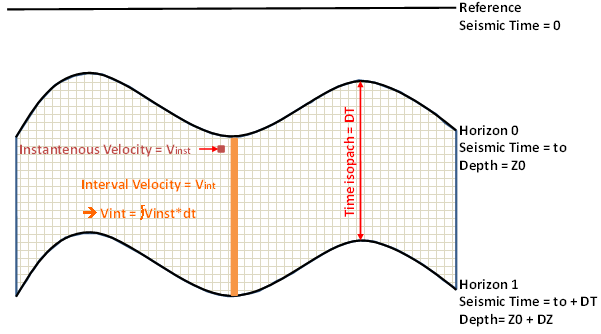| Function type | Instantaneous velocity is a function of depth. This function introduces a linear increase in velocity as depth values increase. |
| Definition of parameters |
V0 = constant velocity factor (instantaneous velocity at the surface). K = constant compaction factor. |
| Operational applications | Useful when geology presents linear compaction (often confirmed by measurements at least in clastic environments). |
$$
V_{inst} = V0 + k \times Z
$$
\( \Rightarrow \) Hypothesis 1: \( Z = Z(t)\)
$$
\Rightarrow V_{inst}(t)=V0+k \times Z(t)
$$
\(
\Rightarrow \frac{DZ(t)}{dt} = V0 + k \times Z(t) \equiv
\)
first order differential equation
\( \Rightarrow \) General solution \( Z(t) = Ce^{kt}- \frac{V0}{k} \)
With \( Z(0) = 0 = C – \frac{V0}{k} \Rightarrow C = \frac{V0}{k} \)
\(
Z(t) = \frac{V0}{k} \left( e^{kt} – 1 \right)\)
&
\( V_{inst} = V0e^{kt} \)
$$
\boldsymbol{
DZ = \int_{t_0}^{t_0+DT} V_{inst}dt = \int_{t_0}^{t_0+DT} V0 \times e^{kt} dt
}
$$
$$
\boldsymbol{
DZ= \frac{V0}{k}e^{kt_0} \times \left( e^{kDT} – 1 \right)
}
$$
$$
\boldsymbol{
V_{int}= \frac{V0}{k \times DT}e^{kt_0} \times \left( e^{kDT} – 1 \right)
}
$$

